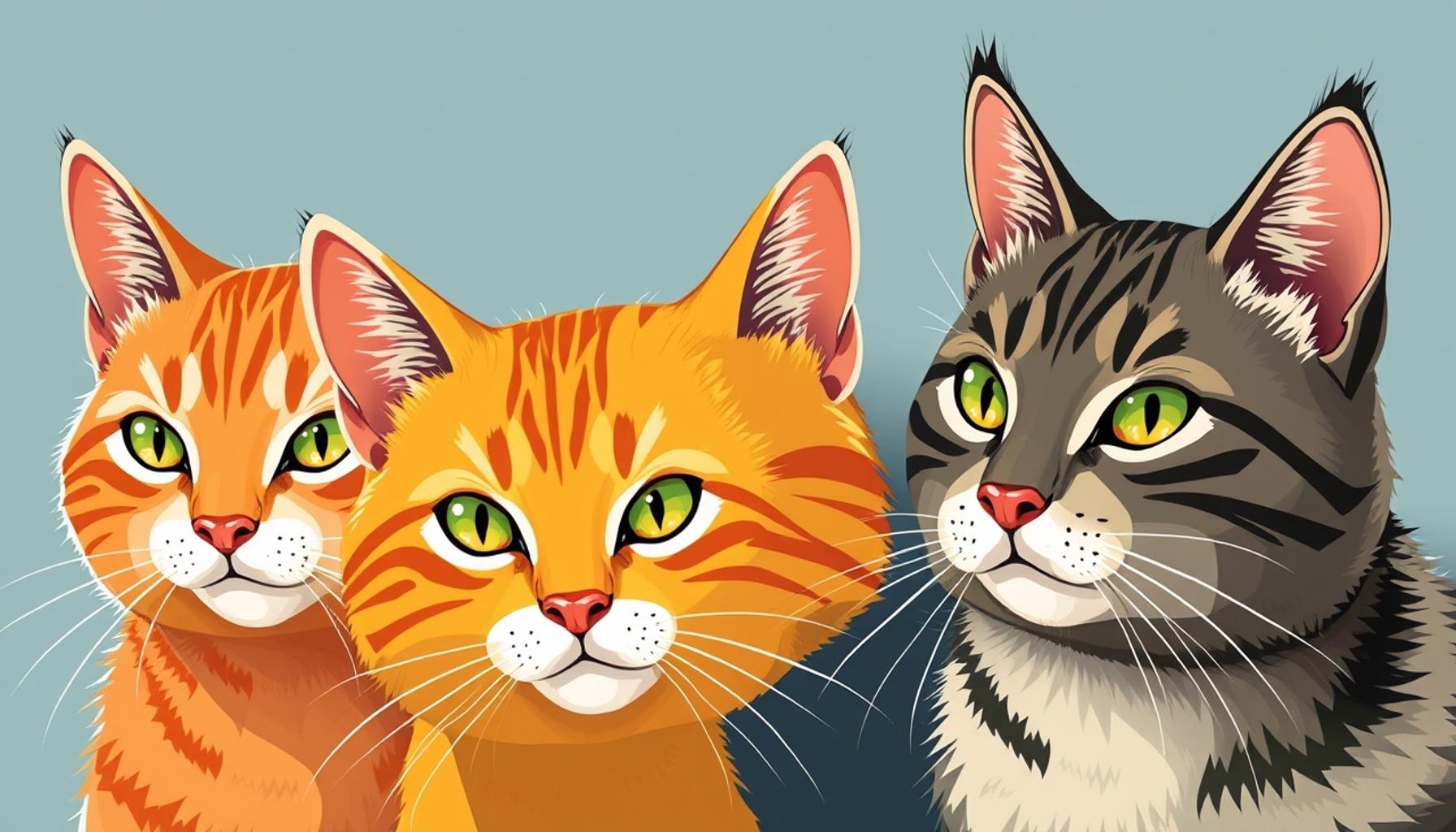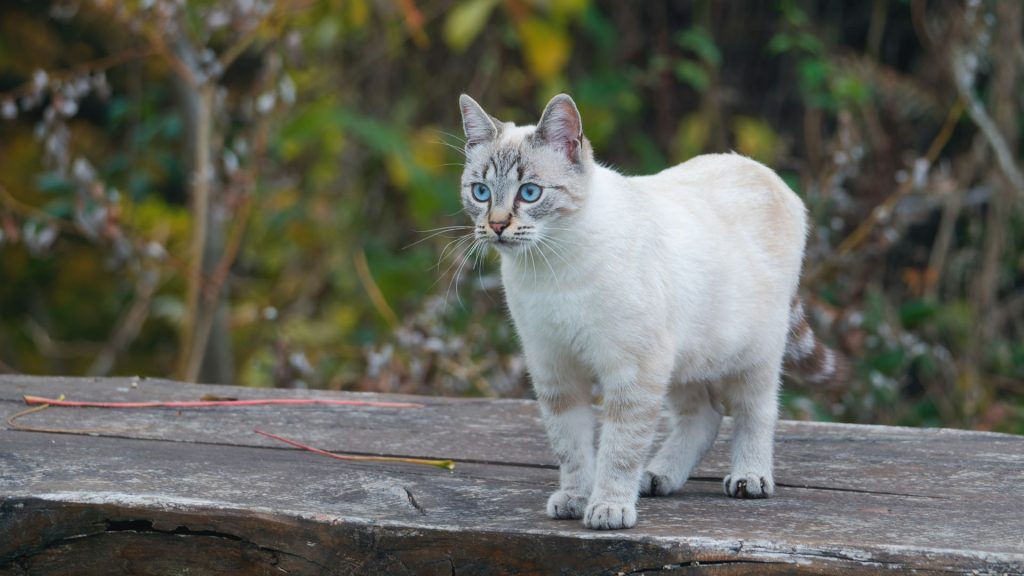Cat Breeds with Unique Behaviors: Understanding the Personality of Each Species

Understanding Cat Personalities
Did you know that not all cats are created equal? Each cat breed comes with its own unique quirks and behaviors that can delight or intrigue owners. Understanding the personality of these breeds is essential for potential cat parents looking to choose the right companion.
Unique Traits Across Breeds
From the playful Bengal to the affectionate Siamese, the characteristics of various breeds greatly enhance the feline experience. Some standout behaviors include:
- Maine Coons: Known for their dog-like loyalty and playful disposition, Maine Coons are among the largest domestic cat breeds. These gentle giants often enjoy interactive play and can even be trained to fetch, making them ideal companions for active families. Their friendly demeanor allows them to get along well with children and other pets, fostering an engaging household environment.
- Scottish Folds: Famous for their cute, round faces and gentle temperament, Scottish Folds are easily recognizable. They are typically calm and affectionate, often following their owners from room to room, eager for companionship. A characteristic trait of this breed is their unique ear shape, which folds forward and down, contributing to their adorable appearance and making them look perpetually kitten-like.
- Ragdolls: Renowned for their docile nature and tendency to go limp when held, Ragdolls are perfect for those who desire a loyal lap cat. This breed is known for its sunny disposition and sociable behavior, often greeting family members at the door. They thrive on human interaction and can even learn tricks or commands, showcasing their intelligence.
The behaviors of these breeds can significantly impact how they interact with humans and other pets. For instance, while a Bengal may engage in high-energy play, a Persian could be more laid-back and content to observe from a cozy spot. Understanding these nuances is vital for building a harmonious home for both pets and their humans. A fantastic way to gauge a cat’s personality is through socialization; observing a cat’s reaction to playtime or interaction can provide insights into whether it will fit well with your lifestyle.
As potential cat owners explore their options, considering the unique traits of various breeds enables them to find a feline friend that aligns with their personality and household dynamics. With such a diverse array of cat breeds, there is much to discover about the fascinating world of feline behavior. In the end, understanding a cat’s traits not only enhances the ownership experience but also helps cultivate a loving and enriched environment for these beloved pets.
DON’T MISS: Click here to learn about keeping your pet healthy with a balanced diet

Diverse Behavioral Patterns in Cats
Understanding the unique behaviors of different cat breeds is a fascinating journey into the complexities of feline companionship. Each breed showcases its own set of traits influenced by genetics, history, and environment, which translates into varying behaviors that can captivate even the most seasoned cat lovers. For potential cat owners, recognizing these differences is crucial not only for choosing a breed but also for fostering a harmonious relationship with their new pet.
Behavioral Highlights of Popular Breeds
Exploring some standout cat breeds and their behavioral traits can help potential owners determine which feline might fit best in their lives. Here’s a closer look at several breeds known for their unique behaviors:
- Bengal: Renowned for their striking leopard-like appearance and high energy, Bengals are exceptionally active and playful cats. They thrive on interactive play and often engage in seemingly endless games of chase. This breed is also known for its intelligence, as they can learn tricks and even enjoy playing fetch, making them a great choice for engaging with humans. However, their high activity levels require time and effort from owners to match their enthusiasm.
- Siamese: With their chatty disposition and strong social nature, Siamese cats are known for forming incredibly close bonds with their owners. Their vocalizations, ranging from meows to chirps, can be quite expressive, as they often use their voices to communicate their needs and desires. These cats require attention and can become quite attached to their humans, often demanding companionship and showing their displeasure when left alone.
- Persian: The Persian breed is a testament to the saying “calm and collected.” These cats tend to be more laid-back and enjoy lounging in their favorite spots, often preferring a quiet environment. While they are affectionate and loving, they exhibit a more reserved demeanor compared to their playful counterparts. Their relaxed nature may appeal to owners seeking a more tranquil feline companion.
- Abyssinian: Known for their energetic and curious personalities, Abyssinians are highly interactive and love to explore their surroundings. This breed often exhibits behaviors akin to a “dog-like” curiosity, where they enjoy investigating their environment and seeking out new experiences. Their playful and active nature requires plenty of stimulation, making them ideal for owners who can provide ample engagement.
Understanding the unique behaviors of these breeds is critical in ensuring a successful pet-owner dynamic. A cat’s personality can impact its interactions not only with humans but also with other pets in the household. For example, while a lively Bengal might revel in boisterous playdates, a more reserved Persian could prefer quiet companionship. By carefully considering a cat’s behavioral tendencies, potential owners can enhance the quality of life for both themselves and their future feline friend.
As prospective cat parents immerse themselves in the study of various breeds, it becomes clear that each cat offers a distinct experience filled with personality and charm. This exploration goes beyond mere ownership; it’s about forging meaningful bonds and addressing the specific needs dictated by each feline breed’s temperament.
| Cat Breed | Unique Behavior |
|---|---|
| Siamese | Highly vocal, often mimicking human sounds to engage. |
| Maine Coon | Known for their dog-like behavior, affectionate and friendly. |
| Bengal | Loves to play in water, showcasing their energetic nature. |
| Ragdoll | Laidback personality, often goes limp when held – truly, a ‘ragdoll’! |
Each cat breed possesses distinctive behaviors that make them intriguing companions and reflect their unique personalities. For instance, the Siamese is highly vocal, often engaging deeply with their owners, which can create strong bonds. This breed’s ability to mimic human sounds makes them not just pets but communicative companions. On the other hand, Maine Coons are known for their friendly demeanor and can exhibit a dog-like loyalty, making them excellent family pets.The Bengal cat stands out for its playful nature, often displaying a fascination with water that can surprise new cat owners. This breed thrives on interaction and requires a stimulating environment to keep their energetic personalities engaged. Lastly, the Ragdoll, often referred to for its docile temperament, tends to relax completely when held by its owner, making it a favorite for those seeking a loving and reassuring feline friend.Understanding these unique behaviors not only enriches the human-animal bond but also provides insight into the care these breeds require, improving their quality of life and ensuring they thrive in their environments.
DISCOVER MORE: Click here for essential tips on your dog’s nutrition
Delving Deeper into Feline Personalities
As we navigate the rich tapestry of cat breeds, it becomes increasingly evident that each species not only brings unique physical appearances but also distinct personalities that shape their behavior and interactions with humans. Understanding these differences can enhance the cat ownership experience, ensuring that potential owners find the right match for their lifestyle and preferences.
Unique Traits of Less Common Breeds
Beyond the well-known breeds, a myriad of less common cats display equally captivating behaviors. Here are a few breeds worth exploring:
- Scottish Fold: Famous for their adorable folded ears, Scottish Folds are also known for their quirky behavior. These cats tend to develop strong connections with their families and often follow their owners around the house. They are generally friendly and can vary from being playful to enjoying lazy afternoons on the couch. Their adaptability allows them to fit into a variety of living situations, making them great companions for both singles and families.
- British Shorthair: With their stocky builds and round features, British Shorthairs are often characterized by their easy-going nature. They tend to be quite independent and can entertain themselves without needing constant attention. However, they are also affectionate and enjoy socializing, though their manner may be more subdued compared to more energetic breeds. This breed is often recommended for those who appreciate a laid-back companion but still desire moments of interaction.
- Ragdoll: Named for their tendency to go limp when picked up, Ragdolls are exceptionally docile and gentle cats. They require a bit of attention and love to be held and cuddled, often resembling a “puppy-like” demeanor. Their affectionate nature makes them perfect companions for families or individuals seeking a loyal feline friend that enjoys human interaction.
- Norwegian Forest Cat: Known for their striking fluffy coats and robust build, Norwegian Forest Cats have a combination of playful and independent traits. They adapt well to changes in environment and can occupy themselves for hours with exploration. Their natural climbing instinct leads them to seek high perches, encouraging owners to provide vertical spaces for them to explore. This breed shines in homes that can offer them the freedom to roam and engage in their natural behaviors.
When considering specific breeds, it’s essential to understand that individual personalities can vary widely even within the same breed. For instance, while Ragdolls are generally known for their laid-back demeanor, there may be some who possess a more lively spirit. Similarly, the energy levels among Bengal cats can fluctuate, with some being more laid-back than their counterparts. Consequently, observing behavior and socialization from an early age can play a significant role in shaping an individual cat’s temperament.
The Importance of Environment and Interaction
Environmental factors and owner interaction significantly influence the behaviors of cat breeds. A nurturing environment filled with stimulation—such as toys, climbing trees, and places to hide—heightens a cat’s natural instincts and promotes happiness. Furthermore, the quality of engagement with human companions can shape how sociable or independent a cat becomes. Breeds like the Siamese may thrive in homes where they receive ample attention and are part of daily activities, while others like the British Shorthair may prefer a more relaxed approach.
Recognizing that personality traits are not solely dependent on breed allows owners to appreciate the nuanced behaviors exhibited by each cat. Understanding these traits can lead to a more fulfilling relationship, ensuring that both the cat and human thrive together in a harmonious setting.
LEARN MORE: Click here to discover the importance of a balanced diet for your pet
Conclusion: Embracing the Unique Personalities of Cat Breeds
As we conclude our exploration into the fascinating world of cat breeds with unique behaviors, it becomes apparent that each breed offers a distinct personality that can enrich the lives of their human companions. From the sociable Scottish Fold to the independent British Shorthair, these cats boast characteristics that not only define them but also cater to the diverse preferences of potential cat owners. Understanding these traits is crucial in making informed choices when selecting a feline friend that aligns with one’s lifestyle.
It is important to recognize that breed characteristics can serve as a guideline, but individual cats may exhibit behaviors that diverge from norms. The interplay of environmental factors and human interaction plays a significant role in shaping how these woolly companions express themselves. By creating an engaging and loving home environment, owners can cultivate the best aspects of their cat’s personality, ensuring a harmonious relationship.
As you embark on the journey of cat ownership, take the time to appreciate the unique traits of each breed, observing their behaviors and preferences. Whether you’re drawn to the energetic antics of a Bengal or the gentle nature of a Ragdoll, understanding their distinctive personalities will not only foster a deep bond but can also lead to a rewarding companionship. Dive deeper into the alluring traits of these breeds and discover the joy that comes from embracing the myriad personalities within the feline world.


